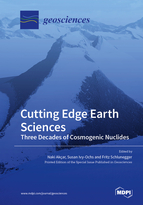Cutting Edge Earth Sciences: Three Decades of Cosmogenic Nuclides
A special issue of Geosciences (ISSN 2076-3263).
Deadline for manuscript submissions: closed (31 January 2022) | Viewed by 36977
Special Issue Editors
Interests: interaction between the geosphere, climate and human societies during the Quaternary; Quaternary geology; glacial geology; geomorphology; cosmogenic nuclides; natural hazards; paleoclimate; terrestrial Arctic; Antarctica
Interests: geomorphology; Quaternary geology of the Alps; cosmogenic nuclides; glacial geology; landslide geomorphology; periglacial geomorphology; geochronology; paleoclimatology
Special Issue Information
Dear Colleagues,
Over the past three decades, a better understanding of the physical processes responsible for the production of cosmogenic nuclides, as well as improvements in sampling, analytical sample preparation, and analytical techniques, have significantly increased the reliability of the cosmogenic nuclide technique and accelerated the wide applicability of cosmogenic nuclides to solve geological problems in Earth Sciences. Today, cosmogenic nuclides are an amazingly versatile tool for the dating of landforms and deposits, and for deciphering landscape evolution processes during the Quaternary. Cosmogenic nuclides have been widely applied in the dating of Quaternary ice volume fluctuations, and volcanic and palaeoseismic events as well as in quantifying surface and/or rock uplift and denudation rates. Moreover, due to the sensitivity of cosmogenic nuclide accumulation to surface erosion and depth below the surface, the application of the technique has led to significant breakthroughs in establishing terrace chronologies, and the rates and styles of local and large-scale erosion, soil development, and landscape evolution. This Special Issue, dedicated to three decades of cosmogenic nuclide research in the Earth Sciences, invites novel applications of cosmogenic nuclides (3He, 10Be, 14C, 21Ne, 26Al, and 36Cl including the new and less frequently used nuclides like 38Ar and 53Mn) in diverse disciplines in the Earth Sciences, as well as contributions from purely methodological and measurement arenas (AMS and noble gas mass spectrometry).
PD Dr. Naki Akçar
Prof. Dr. Susan Ivy-Ochs
Prof. Dr. Fritz Schlunegger
Guest Editors
Manuscript Submission Information
Manuscripts should be submitted online at www.mdpi.com by registering and logging in to this website. Once you are registered, click here to go to the submission form. Manuscripts can be submitted until the deadline. All submissions that pass pre-check are peer-reviewed. Accepted papers will be published continuously in the journal (as soon as accepted) and will be listed together on the special issue website. Research articles, review articles as well as short communications are invited. For planned papers, a title and short abstract (about 100 words) can be sent to the Editorial Office for announcement on this website.
Submitted manuscripts should not have been published previously, nor be under consideration for publication elsewhere (except conference proceedings papers). All manuscripts are thoroughly refereed through a single-blind peer-review process. A guide for authors and other relevant information for submission of manuscripts is available on the Instructions for Authors page. Geosciences is an international peer-reviewed open access monthly journal published by MDPI.
Please visit the Instructions for Authors page before submitting a manuscript. The Article Processing Charge (APC) for publication in this open access journal is 1800 CHF (Swiss Francs). Submitted papers should be well formatted and use good English. Authors may use MDPI's English editing service prior to publication or during author revisions.
Keywords
- Quaternary
- Landscape evolution
- Cosmogenic nuclide
- Surface exposure dating
- Burial dating
- Isochron-burial dating
- Depth-profile dating
- Erosion rates
- Accelerator mass spectrometry
- Geochronology
- Neotectonic
- Denudation rates






